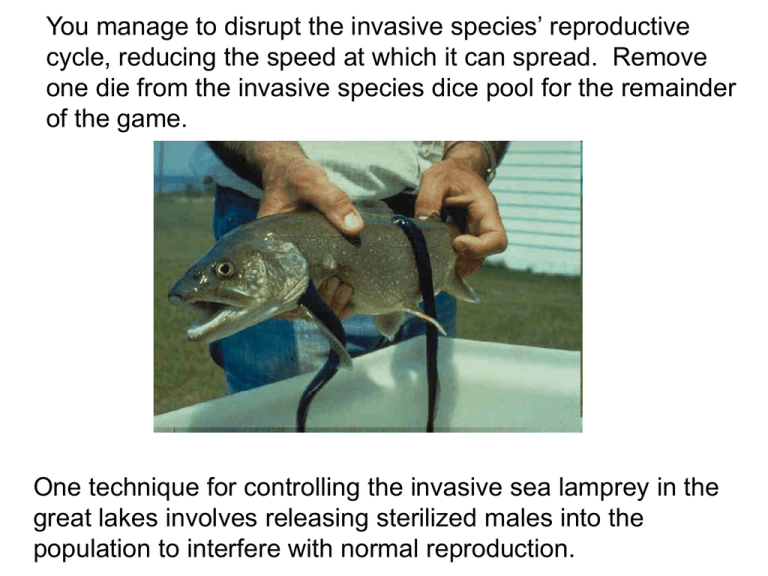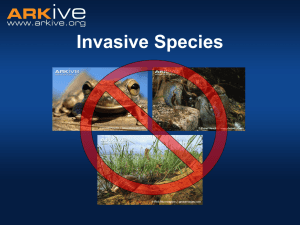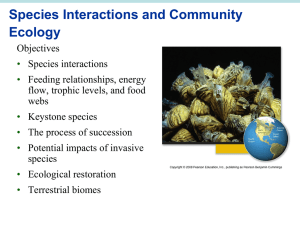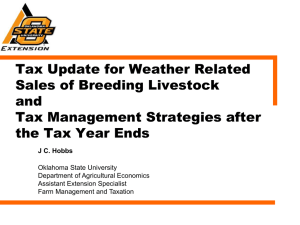Invasive-Species-Control-Cards
advertisement

You manage to disrupt the invasive species’ reproductive cycle, reducing the speed at which it can spread. Remove one die from the invasive species dice pool for the remainder of the game. One technique for controlling the invasive sea lamprey in the great lakes involves releasing sterilized males into the population to interfere with normal reproduction. You manage to develop a species specific herbicide/pesticide. Remove the invasive species from any one county you wish (note: this county can still be re-invaded later). One control method for invasive sea lampreys uses specific chemicals to kill sea lamprey larvae. You manage to develop a species specific herbicide/pesticide. Remove the invasive species from any two counties you wish (note: these counties can still be reinvaded later). In California, one control method for invasive yellow starthistle involves the application several herbicides. You manage to develop a species specific herbicide/pesticide. Remove the invasive species from any three counties you wish (note: these counties can still be reinvaded later). Herbicides are sprayed on invasive garlic mustard in early spring or late fall when other plants have not yet appeared or have already died. You manage to develop a species specific herbicide/pesticide. Remove the invasive species from any four counties you wish (note: these counties can still be reinvaded later). Chemicals such as chlorine are used to remove the invasive zebra mussels from water intake pipes. You manage to develop a species specific herbicide/pesticide. Remove the invasive species from any five counties you wish (note: these counties can still be reinvaded later). One method of eliminating Asian carp uses a chemical toxin known as Rotenone which can kill fish. You have released a predator to kill the invasive species. Choose an invaded county to release the predator in. The invader is automatically removed from that county. Roll three dice, any neighboring counties with values less than the sum of the dice are cleared of invaders (these counties can never be re-invaded). In several states invasive purple loosestrife has been controlled by releasing leaf-feeding beetles that eat the purple loosestrife. You create a physical barrier to block the spread of the invasive species. Choose any three adjacent counties that have not yet been invaded. These counties can now never be invaded for the rest of the game. Barriers are constructed in streams and rivers to block the entry of invasive sea lamprey. You manage to organize community members to physically remove the invasive species from the area. Roll one die, whatever you roll you can remove the invasive from that many counties. In many communities people will actively pull up the invasive garlic mustard as a means of controlling its spread. Poor seasonal weather conditions have slowed the spread of the invasive species. The total for the invasive species next dice throw is reduced by 5. You manage to create several non-physical barriers (eg. electric barriers) to limit the spread of the invasive species. Choose any three counties and permanently raise their value by 5. Electric barriers produce an electric field which is uncomfortable to the invasive Asian carp. You are researching a virus that you think may successfully reduce the invasive species population. If you collect the other research card you can release the virus. Count up the number of invaded counties, remove the invasive species from half of these counties (Rounding down. Note: these counties can be re-invaded) In Australia, a virus has been used to reduce the population of the invasive European rabbit. You are researching a virus that you think may successfully reduce the invasive species population. If you collect the other research card you can release the virus. Count up the number of invaded counties, remove the invasive species from half of these counties (Rounding down. Note: these counties can be re-invaded) In Australia, a virus has been used to reduce the population of the invasive European rabbit. Humans accidentally carry the invasive species to a new location. The invasive species may choose any one county on the map and automatically invade. Zebra mussels were accidentally transported from Europe into the great lakes in the ballast water of ships. Favorable seasonal weather allows the invasive species to spread more rapidly this year. Add 5 to the invasive species’ next dice throw. New adaptations in the invasive species allow them to recover from previous control methods. If the invasive species dice pool was previously reduced it is now returned to three dice. The Brazilian water hyacinth is a flower that relies on pollinators to help it cross-pollinate in its native habitat. In the Caribbean Islands, where it is invasive, there aren’t enough good pollinators, so it has adapted to become a self-pollinator. New local laws change human land use patterns creating a disturbance that makes it easier for the invasive species to spread. If the invasive species dice pool was previously reduced it is now returned to three dice. Many invasive species are able to spread very rapidly through disturbed habitat, such as new roads or building sites. Warmer weather due to climate change has created more mild habitats in the upper peninsula. The value of all counties in the upper peninsula is permanently reduced by 3. Climate change has increased the length of summer, allowing the invasive species to complete its life cycle more rapidly, and spread more quickly. Add 1 to all dice throws made by the invasive species for the remainder of the game. Global climate change has allowed the musk thistle, an invasive species in Eastern North America, to increase it’s height, allowing the seeds to disperse further. The local DNR has declared an open hunting season on the invasive species. Choose any four invaded counties, for each county the invasive species must roll one die, if a 5 or 6 is rolled the invasive remains, if a lower number is rolled the invasive is removed from that county. (Note: these counties can be re-invaded) To help control the spread of the invasive Burmese python in Florida, the state has created a python hunting season. You manage to infect the invasive species population with a parasite that slows their spread. For the remainder of the game, all dice throws by the invasive species are reduced by 3. A newly proposed method for controlling the spread of cane toads in Australia involves using a parasitic lung worm which physically slows the toads’ movement. You are able to set up several monitoring stations in different counties to track the spread of the invasive species which allows you to more precisely target your control methods. Choose 4 counties and permanently raise their value by 3. In Australia, monitoring stations have been set up to listen for the call of the invasive cane toad as a means of tracking the spread of the toads. The invasive species is released by humans into a new habitat after being kept as a pet. The invasive species may choose any one county on the map and automatically invade. The Burmese python has become invasive in Florida as a result of pet owners releasing the snakes into the wild once they become too big to keep. Local governments have put several laws in place that make it more difficult for humans to accidentally spread the invasive species. Choose three counties and permanently raise their value by 3. To help prevent the spread of the invasive emerald ash borer throughout the Eastern U.S., bans have been put in place that restrict the transport of firewood. You manage to convince the local community to begin eating the invasive species to slow its population growth. Choose any three invaded counties, for each county the invasive species must roll one die, if a 5 or 6 is rolled the invasive remains, if a lower number is rolled the invasive is removed from that county. There has been a push to convince people to take up eating Asian carp as a means to limit their population growth.











